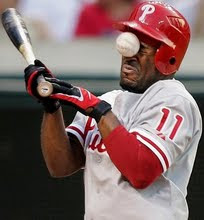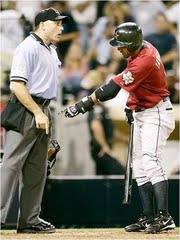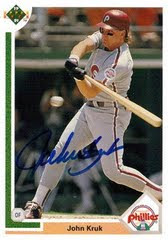My latest article for The Hardball Times.
One of a series on dilemmas facing major league teams this winter.
There are three ways to build a baseball team, though the three methods are the ends and the middle of a continuum. The White Sox seem stuck at one end, and it's not clear how they can change that this offseason.
The first way to build a contender is organically, relying heavily on successful scouting and development of players in the farm system. This is the method the Tampa Bays Rays have followed so successfully, and though not the easiest way to build a team—it requires good projection by scouts—it is most appealing method for small market teams.
Of course, not even the Rays' deep farm system can churn out a full 25-man roster, so organic growth must be supplemented by shrewd trades and free agent signings. This means exploiting market inefficiencies and avoiding brand names, like signing Kyle Farnsworth ("washed up") and letting Rafael Soriano ("the next Jonathan Papelbon") walk. Because young talent is cost-controlled, and because shrewd free agent signings tend to be some combination of short-term commitment and relatively low-cost, "misses" in current years tend to have a lower impact on future years. At the same time, more players are required to contend because the young talent tends to be more raw. The need for more good decisions is especially true when the organizational philosophy is to build a stable of young 3 WAR players with upside, rather than around a perennial 8 WAR player.
At the other extreme of team building is signing players who are already good to fill out your roster through free agency pool and big trades. This approach is somewhat attractive because players between ages 27 and 30 tend to "be what they are" and are more projectable in the years immediately following. These players also are more established, meaning they can sell jerseys. On the other hand, these players cost more money and more contract years, or cost big prospects who are young, cost-controlled and potentially the source of many future years of value. The back end of most large free agent contracts, where money is often backloaded, can turn once-stars into untradable albatrosses. And overvaluing a free agent or acquired player—think Barry Zito or Vernon Wells—can make even the early years of the contract ugly.
In this category, misses not only hurt now, but they can cripple a team's future. It can have big results, but it requires the franchise using it to be able to eat massive contracts, or otherwise be so bloated with inefficient contracts for several seasons that it is unable to contend. This approach is best embodied by the Yankees, and teams that are trying to "win now" by mortgaging some or all of their future (the 2008-2011 Brewers, for example). Teams that employ this strategy tend not to get high draft picks (surrendered to Type A signings), and any drafting successes they do have are often used as leverage to bring in "younger" talent through trades.
The middle ground between these two strategies blends signings and drafting to form the nucleus of the team. This could be done by signing a young free agent stud like Prince Fielder and using the farm system to build around him with young. above-average major league talent. It could alternatively mean developing a superstar stud (think Albert Pujols, Evan Longoria or Troy Tulowitzki), signing him for a very long time, and then using the free agent market and swapping young talent to fill team holes. The middle ground can take many creative forms, the best of which are embodied by the Cardinals and Rockies. "Misses" are can be stomached and "hits" do not need to be as dramatic because moves tend to be one at a time as needed and built around some long-term nucleus. Provided the middle ground is done right, rebuilding and reloading should be the "simplest" under this method because the right young players will steadily trickle in, contracts won't cripple, and free agency can be used to fill the needs the farm system cannot provide.
The White Sox are the small market team of big markets. Compared to the Cubs, Yankees, Red Sox and even Dodgers, the White Sox are the Pirates. They are just barely a top 10 revenue franchise, according to Forbes estimates. Yet, they've tried to build a team like the Yankees. Their 2011 payroll was seventh overall, just a few million behind the Cubs. Depending on what the Cubs, Yankees and Angels do this offseason, the Sox could have the fourth highest payroll in baseball next year, behind only the Yankees, Red Sox and Phillies.
General manager Kenny Williams uses his farm system as a trade block. Sometimes this approach has worked, as with the team's trades for Jim Thome, Gavin Floyd and John Danks. More often, however, these trades have not worked out, and when they didn't, the Sox either sold low or cut bait (e.g., Nick Swisher). Being trade-focused, the White Sox have not been nearly as heavy-handed in the free agent market as the Yankees, which is why unjustified moves like using Mark Kotsay at DH did not cripple the team's future. Alas, given their lack of player development, heavy reliance on building through trades and recent spending binge spending, the result has been practically the same. Only the White Sox do not have the same resources as the Yankees to eat bad contracts—or, ironically, as good a farm system to reload through. (Who expected the Yankees to have a borderline top five farm system?)
What does this mean for the Sox?
In theory, the Sox have the short-term pieces in place to compete. They were just a few games under .500 in a relatively weak division last year, and BABIP luck did not fall their way. Then again, the Indians have upgraded their weak pitching with groundball specialists Ubaldo Jimenez and Derek Lowe, the Twins can't be any worse next year than they were this year, and the Tigers are still in a very good competitive position.
Who knows if Paul Konerko can keep up his late-career resurgence, though there is no reason he cannot be a +3 WAR first baseman if healthy in 2012. (Oliver forecasts a .289/.359/.497 triple-slash line). Alexei Ramirez, athletic and just 30, has turned into an All-Star shortstop.
You have to imagine that Alex Rios and Gordon Beckham have nowhere to go but up from last year, right? Rios' xBABIP says he should have hit .275 or so last season, but except for April and May of 2010, he has been a negative asset for the Sox in every other month. Rios does not have much room to improve at 31, and he may just be an overpaid league average player at this point. Still, league average is not awful.
And then there is Adam Dunn. Even though he fell off horribly, Dunn's true talent line lies somewhere in between his 2008 and 2011 numbers. In the world according to xBABIP, Dunn's expected BABIP was .060 points higher than his actual, meaning his "luck neutral" slash line last year should have been a still pathetic .191/.319/.317. Dunn's appendectomy may have had some impact on his swing and ability to turn on the ball last season. Expect a lot of rebound.
But rebound means a .235/.350/.450 slash line—or about what Carlos Pena did for the Cubs this past year. That would be productive, and add a relative offensive boost to the 2012 White Sox, but it is not the impact bat they quite expected when they handed Dunn $56 million. They might as well have just re-signed Jim Thome who, despite playing in only 201 games over the past two years, has produced 4.5 wins above replacement for under $5 million. Compare that to the -4.3 WAR of combined DH production of, and the $17.3 million the Sox paid to, Kotsay, Manny Ramirez, and Dunn over the past two seasons. A +2 WAR season for Dunn next year is entirely in the cards, but the Sox will be overpaying for that production by about 35 to 50 percent, depending on the price of a win this offseason. Given Carlos Quentin's defense, it is a wonder that the Sox needed to bring in a DH at all (although when you look at defense through Jermaine Dye-tinted, rose colored glasses, everyone looks like Franklin Gutierrez).
Mark Buehrle may or may not re-sign, but the 2012 roster is looking a lot like the 2011 roster with a healthier Jake Peavy and an emerged Sergio Santos. They should be very competitive in the short run. The long run is a much uglier story.
The White Sox will have two major players hitting free agency after 2012 in Quentin and Danks. Peavy, who has a $22 million team option for 2013, will almost unquestionably be let go for the price of the $4 million buyout, but he'll save the team a net $13 million. Floyd might also reach free agency, though I expect the White Sox to exercise his $9.5 million team option. Meanwhile, the Sox' payroll will experience a mild offsetting payroll jump from the back-loaded contracts of Dunn, Rios and Ramirez—this before any possible arbitration raises. The White Sox already have a payroll just under $130 million, and it is a serious question whether they can maintain or extend their payroll beyond that amount. Anyone who thinks that young players Dayan Viciedo (projected .748 OPS), Alejandro De Aza (projected .752 OPS), Zach Stewart (projected 5.30 ERA), and Phil Humber (projected 4.30 ERA) are the answers to the Sox' future holes might be strongly mistaken. That's not to mention the current hole at third base (Brent Morel projects for a .703 OPS).
Through a decade-plus of trading, Williams has decimated the White Sox farm system. At least that much is certain. Heading into 2011, the White Sox were universally regarded as having a bottom five farm system. Marc Hulet went so far as to rank the Sox farm system as the worst in baseball last year, behind even the Brewers. Especially with the graduation of Chris Sale from prospect status, the Sox do not have anyone who would qualify as a prospect, let alone a top 10 prospect on most other teams.
The Sox only have two viable choices: Go all in for 2012, or hold a 50-75 percent off Macy's Spring Day Sale, hope to save some money and start the rebuilding process sooner than later by targeting very young prospects in low levels in the minors. I doubt Williams will opt for the latter strategy, especially not after all the White Sox have tried to do to rebuild the fan base over the past decade. As a result, we may see Williams try to spin a few trades and short-term-risk signings to shore up the 2012 roster. If the Sox are in contention by the All-Star break, I would not be surprised to see Viciedo on the move. An underperforming team would likely see Danks and Quentin depart early.
At some point, the White Sox are going to have to start reloading for the future, and they'll have to start from square one. At the moment, they do not have a nucleus core of players who are relatively young and figure to be productive for a long time. Ramirez, Rios and Dunn will be around the longest, and they're all in their 30s. Beckham's fallen off the map since 2009—those second-half flashes of hope in 2010 seem lost in a putrid 2011 campaign. Tyler Flowers projects as potentially a slightly above average major leaguer, but he's no core-nucleus to build around.
The future is ugly for the White Sox. But hey, at least Ozzie Guillen is gone and 2012 should be fun to watch. The White Sox are approximately in the same boat as the Cubs were heading into 2009, only with a lot fewer projected wins.
2012 Offseason Outlook: The Chicago White Sox
Posted by
David "MVP" Eckstein
on Wednesday, November 9, 2011







1 comments:
Wow! What an impressive thoughts you had. I am amazed with your blog and I enjoyed reading it. Thank you for sharing.
Apple
Post a Comment